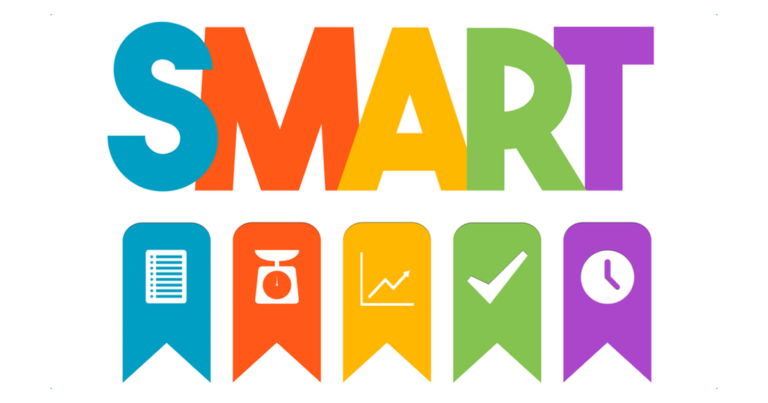As the clock declares January’s arrival and renditions of ‘Auld Lang Syne’ are warbled, listen carefully and you might just hear the utterance of New Year’s resolutions floating into the atmosphere; proclamations of ‘new year, new me’ are celebrated with the clink of a wine glass, and promises are made to quit bad habits, to join a gym, practice more or to continue a positive ritual – many of which are already broken by 12:06am.
Whether the coming of the new decade instills in us a lull or a spark of motivation, goal setting can help clear a Dickensian mind fog and propel us forwards to start accomplishing what we set out to achieve as teachers and singers in the first place. For this, we can turn to a popular acronym.
SMART Goals
Management consultant Peter Drucker was the founder of the ‘management by objectives’ ideology, and is often associated with the SMART goal setting system. This formula is designed to help create clear objectives by breaking them down into five simple steps.
S
- Specific: Imagine it’s lunchtime and your friend has kindly offered to fix you both a snack. You have a real hankering for a delicious sandwich, but are left dissatisfied by the sad looking cheese toastie that is presented to you in a paper napkin. What you meant to express was your real desire for a steak sandwich (medium rare, please) on a bed of rocket with a mustard-mayo dressing and arranged on a plate; but, because your order for ‘a sandwich’ was so vague, you’re left chewing on disappointment.
Specificity enables us to acknowledge what is at the very core of our goal(s), and helps us to outline an efficient plan of action to lead us to accomplishment. For example, if my goal is to ‘increase interest in my business,’ I can make that more specific with: ‘to increase interest in my business via improved website traffic and social media engagement in order to grow my client list by an extra 5 students (and therefore earning an extra ££) by July.’
(note: if steak sandwiches are on the menu in your house – I want an invite!)
M
- Measurable: Being able to mark the progress of each goal is important in sustaining momentum, understanding the current status of the objectives and adjusting the plan of action. If your goal for the day is to write 500-words of a blog on ‘How to Belt’ the increasing word count indicator is marking your progress. If it has no means to be measured how can you be sure that your goal is ‘active’ and in the process of being achieved?
A
- Achievable: Deirdre says: “Within the next four months my aim is to publish a series of books on vocal anatomy, have a voice studio with a £50k profit, and offer private tuition at a second premises. Oh, and I want to marry Taron Egerton, too. Only thing is, my human biology is a bit rusty, I only have five clients and Taron Egerton doesn’t know I exist.”
We have to recognise the difference between what is fantasy and what is realistic. Goals need to be attainable and within our realm of capability, otherwise we are setting ourselves up to fail. Sub-goals might be required to help us achieve the main one; for example, if we want to increase interest in our business but marketing skills are lacking, a sub-goal might be: ‘to spend a month learning more about marketing in order to understand the best strategies to help increase client interest.’
Ambition is key and, for some, being faced with a challenge can be the very portal to motivation. Communicating with our goals with positive language, like ‘I will create valuable video content for my website,’ instead of ‘I’ll try’ might just give us a feeling of internal power to help us get going. The Taron Egerton fantasy, however, is neither relevant nor realistic, so that will have to remain a piece of fiction, I’m afraid, Deidre.
R
- Relevant: The steps we take in order to achieve our goal(s) need to have purpose. If we aspire to be an astronaut, it would be counterproductive to enrol on an ancient history course to study the Aztecs. Equally, if our goal is to be able to accompany our students on the piano proficiently, we wouldn’t spend our time learning to play the saxophone.
T
- Time-based: ‘In my lifetime I want to have composed a selection of arias, and have created an online course helping contemporary singers to learn classical voice.’
Assigning our goals a time-based completion target can encourage new impetus, allowing the objective to feel very present in our life and less of a distant dream. Having more imminent deadlines can feel stressful, but they can also provide us with a sense of action and provide us with some accountability.
We can have more than one goal at a time, but it might be best to avoid having so many that they become overwhelming and, consequently, impossible to juggle.
How we can apply this to our students?
We can encourage our students to use the SMART system, too (which will also play a role in setting our own teaching goals for each individual).
For example, a 17-year old Musical Theatre student arrives at our studio in February and expresses their desire to attend Drama School auditions. We can make this goal more SMART with the statement: ‘to be prepared to confidently attend Drama School auditions from November 2020 by having two contrasting legit, and two contrasting contemporary musical theatre songs ready, along with prepared sheet music and relevant bar cuts clearly marked.’
Here is how the SMART acronym has been applied:
Specific: Instead of vaguely announcing the desire to prepare for auditions we can be more specific about what that entails. This includes having a number of legit and contrasting songs well rehearsed and feeling comfortable, as well as completing sheet music admin.
Measurable: By having the two audition songs prepared for each of the appropriate categories as specified. At the end of each month, we can assess the audition repertoire folder for preparation progress, and identify areas which need more attention. We can record each vocal lesson which can be referred to when measuring improvement, and scheduled audition dates will also help to mark goal progress.
Achievable: The goal is realistic and, with enough effort, the audition material can be thoroughly prepared.
Sub-goal 1: To become more familiar with the legit genre of musical theatre, and repertoire suitable for personal vocal style and abilities.
Sub-goal 2: Work more specifically on singing legit material with the aim of improving the upper register
Relevant: This goal is relevant to the overall aspiration to perform professionally as a Musical Theatre artist, and the sub-goals fall in line with achieving the current objective.
Time-based: By 30th November 2020.
Finally, remember…
Goals can change.
When I was in primary school I specifically remember aspiring to be either a Nun or a Librarian (don’t ask!). Come my teenage years, my goal was to perform professionally in the realm of Musical Theatre and, by my late twenties, my aims were driven in the direction of pursuing a career as a vocal coach. Some clients may express that singing is a hobby and, months later, confess that, really, they would like to do it professionally; others may aspire to sing at a professional level and realise that, actually, this isn’t where their heart lies. The great thing is, goals aren’t set in stone and can be adapted along the way without encroaching feelings of failure.
If you have any questions or comments, or if you would like to share your approaches to goal setting then you can find me and the BAST trainers in the BAST Facebook group.




